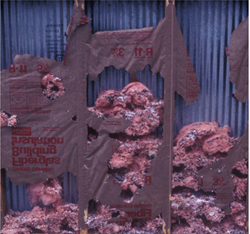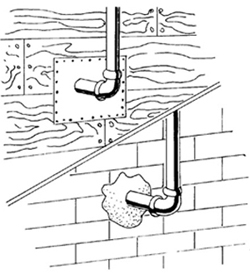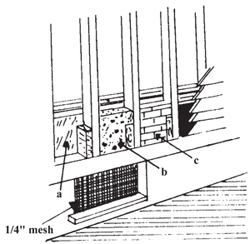G1530
Rodent-Proof Construction — Structural
This NebGuide describes techniques for rodent-proofing existing buildings and those under construction.
Stephen M. Vantassel, Extension Wildlife Damage Project Coordinator
Scott E. Hygnstrom, Extension Specialist — Wildlife Damage
Dennis M. Ferraro, Extension Educator
Richard R. Stowell, Extension Animal Environmental Engineer
- Physical Abilities of Rats and Mice
- Holes and Openings
- Vents and Windows
- Exterior Doors
- Foundations and Floors
- Interior Rodent Control
- Protect Perimeter Insulation
- Acknowledgments
|
Rodents, such as rats (Rattus norvegicus) and house mice (Mus musculus), cause serious damage to the structures and contents of homes, farm buildings, and feed storage facilities. Rodents are notorious for their consumption and contamination of feed and stored grain, but few property owners are aware of how rodent damage to insulation raises heating and cooling bills (Figure 1). Rodents also spread diseases that affect livestock and humans, such as brucellosis, leptospirosis, salmonellosis, swine dysentery, toxoplasmosis, trichinosis, and tuberculosis.
Rodent-proof construction is the first and most important step in reducing rodent damage. Research shows that rodents will reinvade structures through unsecured openings following rodent control programs.
Effective rodent-proofing will help stop the control-reinfestation cycle, but property owners must understand that rodent-proofing will not guarantee rodent-free buildings. Rodents may gnaw new entrances or even be carried into a structure in a box or appliance.
Therefore, the techniques discussed here should be seen as part of an overall integrated pest management (IPM) program that includes monitoring, sanitation, and population control.
Physical Abilities of Rats and Mice
To prevent rodent entry, their capabilities must be understood. For example, rats and mice can:
- run along or climb electrical wires, ropes, cables, vines, shrubs, and trees to gain entry to a building;
- climb almost any rough vertical surface such as wood, brick, concrete, and weathered sheet metal;
- crawl horizontally along pipes, augers, conveyors, and conduit; and
- gnaw through a wide variety of materials, including aluminum sheeting, wood, rubber, vinyl, plastic, and concrete block.
In addition, rats can:
- climb the outside of vertical pipes and conduit up to 3 inches in diameter, climb the outside of larger pipes attached to buildings by bracing themselves against a wall, and climb the inside of 1½- to 4-inch vertical pipes;
- jump up 36 inches vertically and 48 inches horizontally;
- drop 50 feet without serious injury;
- burrow straight down into the ground at least 36 inches;
- reach up to 13 inches along vertical walls; and
- swim half a mile in open water, dive through water traps in plumbing, and travel in sewer lines against a substantial current.
House mice can:
- jump up 18 inches vertically;
- travel up to 1½ miles;
- hang upside-down from screen wire; and
- survive and reproduce at temperatures down to 24°F if adequate food and nesting materials are available.
Holes and Openings
The paired front teeth (incisors) of rats and mice curve slightly inward, making it difficult for them to gnaw on round surfaces larger than 7/8-inch, flat, or harder than iron (such as steel). Thus, when given a rough surface or an edge, they can quickly gnaw into most materials. Take special care to locate and secure all structural crevices. Rats only need slightly more than a ½-inch gap to enter; mice only need slightly more than a ¼-inch gap (Figure 2). Don’t ignore smaller crevices as rodent gnawing can quickly enlarge them.
Common openings occur around augers, pipes, and electrical conduits or cables. Mice typically enter agricultural buildings through the unprotected end of the metal siding (Figure 3). Rats and mice can quickly gnaw through rubber or vinyl weather stops.
 |
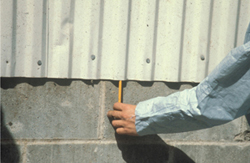 |
|
| Figure 2. Rats can gain entry through holes as small as 1/2 inch in diameter; mice can use holes as small as 1/4 inch in diameter. (Source: Prevention and Control of Wildlife Damage 1994). | Figure 3. Mice can enter the wall space where the ends of metal siding panels are open by gnawing through the weather shield or vinyl gasket. Use concrete, angle iron, or heavy duty flashing to block access to rodents. Photo by Rex O. Baker. |
|
NOTE: The information that follows assumes that the structure is free from unwanted animals. If there is any doubt about whether a hole or gap is being used by an animal, do not close the opening until the species has been properly identified and a control program has been decided upon. Failure to heed this advice may cause further structural damage and personal injury.
To prevent rodent entry:
First, determine if the void is suitable for filling with caulk to stop airflow. If the answer is yes, use an appropriate caulk and backing to stop or reduce potential airflow through the opening. Avoid using foam in locations where it will be exposed to sunlight, as the ultraviolet light will degrade the material.
| Table I. Recommended materials for rodent-proofing. |
| Concrete: reinforced — minimum thickness of 2 inches; not reinforced — 3 ¾ inches. |
| Galvanized sheet metal: 24 gauge or heavier. Perforated sheet metal grills should be 14 gauge. |
| Brick: 3 ¾-inches thick with mortar-filled joints |
| Hardware cloth (wire mesh): 19 gauge, 1/2 x 1/2-inch mesh to exclude rats; 24 gauge, 1/4 x 1/4-inch mesh to exclude mice. |
| Aluminum: 22 gauge for frames and flashing; 20 gauge for kick plates; 18 gauge for guards. |
Second, install a gnaw-resistant barrier (Table I), over the gap to prevent entry (Figure 4). For openings less than ¾-inch wide that cannot be secured by other means, tightly wedge copper or stainless steel wool into the gap. As a temporary measure, coarse steel wool will suffice but it will eventually rust.
Vents and Windows
Use galvanized hardware cloth, hail screen, or welded-wire mesh to cover ventilation openings and windows. Add crossbars to support the screening for large openings or where the screen may be subject to abuse. Stainless steel screens for mushroom-type roof vents are also available. If the opening is an access-way, install the screen on a hinged frame. CAUTION: Screen with a mesh size less than ½ x ½-inch will significantly reduce airflow.
Screens may not be acceptable in livestock buildings where ventilation is already less than adequate. In some locations, small-mesh screen can become clogged with dust or ice. The use of ½-inch x ½-inch screen is a reasonable compromise between ventilation requirements and rodent control.
Clothes dryer vents require special treatment, as improper screening hastens lint build-up and increases the likelihood of fires.
- First, make sure exhaust pipes meet Consumer Product Safety Commission standards.
- Second, properly seal any gaps between the pipes and the structure to prevent mice entry.
- Third, consider installing a dryer vent cover that utilizes a floating ball that secures the vent when the dryer stops.
Exterior Doors
Doors should fit tightly so that the distance between the door bottom and the threshold is less than ¼-inch. Sometimes it’s easier to build up the threshold than to modify the door. Steel pipes make good rodent-proof thresholds and allow doors to swing free when open. Install flashing or a metal channel on the lower edge of doors, particularly softwood doors (Figure 5). The flashing should extend to within 1/8-inch of the edge of the door at the sides and bottom.
Mechanical door-closing devices save time and reduce the likelihood of being propped open. Doors that are left open for ventilation should be equipped with rodent-proof screen doors, or modified so the upper half can be left open for ventilation.
Foundations and Floors
Gaps or flaws often exist along building exteriors where the wall framing or siding meets the foundation. These gaps or flaws provide easy access to rodents. Rats can burrow beneath the floor or foundation of a building that rests on piers or shallow foundation walls. Prevent their entry by extending the foundation walls at least 36 inches below ground. The potential for damage from frost will also be reduced.
Avoid slab-on-grade construction techniques for agricultural buildings, feed bins, fan pads, and feed bunks. The possible savings in initial construction costs is quickly overcome by costs due to rodent damage or the need for more costly control measures.
An alternative option calls for placing 18 inches of compacted sharp gravel under the slab to discourage rodent burrowing. Rodents exert more effort to enter buildings where feed is available. They frequently seek shelter under concrete floors and slabs, where they burrow to find protection. Ideally, you should install floors, slabs, and sidewalks with deep footings, or curtain walls of concrete or ¼-inch mesh wire (Figures 6 and 7).
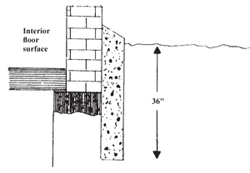 |
 |
|
| Figure 6. Use concrete curtain walls to prevent rats from burrowing under foundations to gain entry to buildings. Curtain walls can be added to existing buildings. | Figure 7. Install hardware cloth, topped by a band of sheet metal, to protect feed sheds, corncribs, and other existing wooden structures. Galvanized hardware cloth can also serve as a curtain wall to prevent rodents from burrowing beneath slabs. |
|
The choice between concrete and wire mesh depends on the expected life of the structure. Nongalvanized wire mesh generally lasts 5 to 10 years depending on its exposure to moisture. Galvanized and/or stainless steel wire mesh last significantly longer and costs significantly less than concrete.
Repair cracks in foundations with concrete or masonry grout. If rats have access to the crawl space of a building, modify the floor to prevent them from getting into the walls (Figure 8).
Maintain a clean, 3-foot-wide, weed-free area around building foundations, concrete slabs, and footings to discourage rodents from burrowing. Maintain the buffer by mowing vegetation regularly or by applying 1½-inch crushed rock to a depth of 3 inches along a 24-inch wide strip (or wider) surrounding the structure.
Interior Rodent Control
When rats or mice are present in a building, pay attention to interior as well as exterior rodent-proofing to remove all sources of shelter. Eliminate hiding places for rodents.
For example, feeders in livestock facilities should have flat bottoms and be designed to keep rodents from finding shelter beneath or behind them.
Pay attention to storage rooms, feed rooms, closets, and other areas where construction may be poorly finished, allowing rodents access to walls, floor spaces, or attics. Poor construction techniques may allow rodents to gain access through materials that are otherwise rodent-proof. Rodents often gnaw into walls at corners or where joints in construction materials provide an edge.
Prevent rodents from climbing walls, particularly in corners, by attaching 12- to 18-inch-wide aluminum sheet metal bands at least 36 inches above the ground or at floor level (Figure 9). Seal openings in walls and floors with sheet metal.
Bags of feed and miscellaneous debris provide shelter to rodents and make rodent control more difficult. Store essential materials on pallets, shelves, or hooks. In addition to sanitation and rodent-proof construction, use traps and toxicants to remove rodents from indoor areas.
Protect Perimeter Insulation
Perimeter insulation is a necessary part of energy-efficient construction. Insulation installed on the exterior of foundation walls, however, is subject to both mechanical damage and destruction by rodents.
To prevent damage to perimeter insulation, use sandwich wall construction that has insulation placed within the concrete. If you place insulation on the outside of a foundation wall or use forms made of foam insulation, use protective coverings such as stucco, cement board, high-density fiberglass-reinforced plastics, or surface bonding products.
Extend protective coverings at least 36 inches below the finished grade. If the protective layer is less than 36 inches below grade, add a horizontal ledge similar to the one shown in Figure 7. Protect all ends and top edges with close-fitting, heavy-gauge metal flashing (Figure 10).
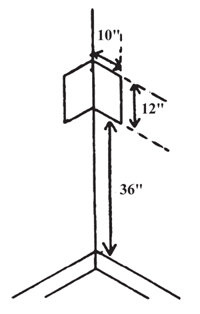 |
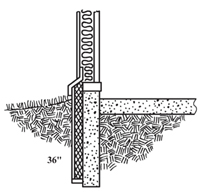 |
|
| Figure 9. Use sheet metal guards at the interior corners of rooms to prevent rodents from climbing. | Figure 10. Protect perimeter insulation that is installed on the outside of a foundation, curtain wall, or stem wall. Install metal flashing along the top and to a depth of at least 36 inches below the soil surface. |
Acknowledgments
This NebGuide is a revision of one written by Scott E. Hygnstrom; Dallas R. Virchow, former Wildlife Disease Management Specialist, USDA-APHIS-Wildlife Services; Dennis M. Ferraro; and Richard R. Stowell.
This publication has been peer reviewed.
Visit the University of Nebraska–Lincoln Extension Publications Web site for more publications.
Index: Wildlife Management
Wildlife Damage Control
2003, Revised January 2009
